How To Use The London Underground
Have you ever opened up a picture of the London Underground and freaked out? All those intersecting, criss-crossing lines with strange yet Monopoly-sounding names on them can be overwhelming at first glance. The first time we visited London, we felt the same — but with time and a few simple lessons, we found riding the Underground not only easy, but part of the adventure.
Public transport is the lifeblood of London. You’ll find buses and black cabs above ground, ferries cruising along the Thames, and of course, the Underground threading beneath the city. Each has its charm — ferries are relaxed and scenic, buses let you sightsee as you ride — but for speed and efficiency, the Underground is hard to beat.
On our last trip, it became our favourite way to get around. Our accommodation was ideally located near both Queensway and Bayswater stations, which meant we had access to multiple lines with minimal transfers. By the end of our first day, we were moving around the city with ease and confidence. After six trips to London, I can honestly say the Tube has gone from intimidating to second nature. Here’s how you can get there, too.
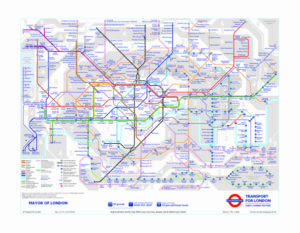
Tube Map
Menu
Planning a Trip on the Underground
The Oyster Card and Other Payment Methods
Understanding the Underground map

Close-up of the tube map
The Tube map looks neat, colourful, and… huge. Don’t let it spook you. The trick is to focus only on the stations you need. When you’re planning your sightseeing, note the nearest station to each place you want to visit. This helps you group your sightseeing into areas rather than zigzagging across the city.
The colours on the map are your best friends. Each line has its own colour, and once you start recognising them, navigating becomes simple. Instead of thinking, “I need the District Line,” you’ll find yourself saying, “We’re on the green one.” It’s a game-changer.
Couples’ Take: Think of the map as a puzzle you’re solving together. Two heads are definitely better than one when the spaghetti of lines first hits you.
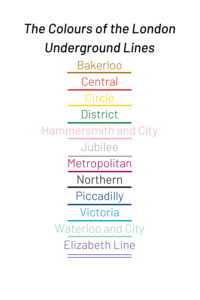
The Colours of the London Underground Lines
Planning a Trip on the Underground
Let’s take an example. Say you’re staying near Bayswater, like we did, and you want to visit the Tower of London.
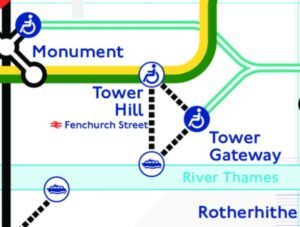
Tower Hill Station
A quick bit of research shows Tower Hill is the closest station. When you look at the map, you’ll see that Tower Hill is on both the Circle (yellow) and District (green) lines. Bayswater also sits on these lines, so it’s a direct ride — no changes needed. Easy.
It’s this kind of planning that takes the stress away. Find your start, find your destination, follow the colour, and see if they meet. If they don’t, then you’ll know where you need to switch lines.
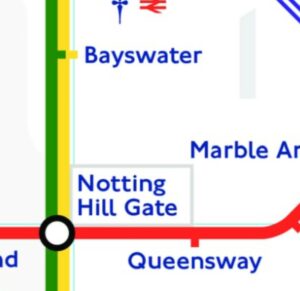
Bayswater and Queensway
The Oyster Card and Other Payment Methods
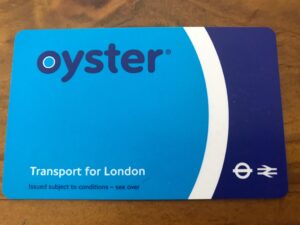
The Oyster Card – London’s Transport card
For ease of use, you’ll want an Oyster card. This little blue card works on the Tube, buses, and even ferries. We picked ours up at Heathrow from one of the ticket machines, and they’re easy to top up at any station. You can also use contactless credit and debit cards, but we’ve always liked having an Oyster card in our wallets. It’s simple, reliable, and feels like a proper Londoner’s pass.
Here’s a link for more on the Visitor Oyster Card from Transport for London: TFL Visitor Oyster Card.
Couples’ Take: Get two cards, one each. It’s quicker at the barriers, and you avoid the awkward shuffle of trying to tap in together with one card.
Getting to the right platform
Once you’ve tapped in, it’s time to find your platform. Each station has clear boards showing the lines that stop there and the direction they’re travelling. Take your time, read the boards carefully, and match your line colour and your stop.
Let’s say we’re heading from Bayswater to Tower Hill on the Circle Line. You’ll want to find the platform heading eastbound, and you’ll see Tower Hill listed on the station board before you even step onto the train.
When We Have a Change mid-journey
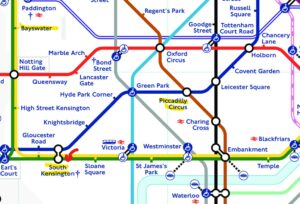
Change at South Kensington
If you’re changing lines mid-journey, the process is the same. Say you’re going to Piccadilly Circus from Bayswater. Bayswater sits on the Circle (yellow) and District (green) lines, but Piccadilly Circus is on the Piccadilly (blue) line. Following the map, you’ll see that South Kensington is where the yellow and blue lines cross. That’s your change point. You simply hop off, follow the signs for the Piccadilly Line, and continue your journey.
Couples’ Take: Snap photos of the signs before heading down. It provides a quick reference if you second-guess yourself, and it’s enjoyable to look back on later.
Riding the Tube

An example of multiple lines on a Train
Once you’re on board, the journey takes care of itself. Each carriage has maps showing the line you’re travelling and the stops ahead. Digital displays announce upcoming stations, so you’ll know exactly when your stop is approaching. If you’re changing lines, you’ll see those intersections marked clearly.
And if you ever feel lost? Don’t stress. There’s usually a full Tube map posted in each carriage, and Londoners are often kinder than their reputation — plenty of people will help point you the right way if you ask.
Couples’ Take: Sit together and watch the city’s rhythm play out around you. The Tube is busy, noisy, and iconic — but it’s also where you’ll feel like you’ve stepped into the real everyday life of Londoners.
Final Thoughts
The London Underground may look intimidating at first, but once you understand the map, the colours, and the simple process of platforms and line changes, it becomes second nature. After six trips, we wouldn’t dream of exploring London without it.
Couples’ Take: The Tube isn’t just a way to get from A to B. It’s part of the London experience. Learn it together, laugh through the confusion, and you’ll come away with stories as memorable as the landmarks themselves.

Looking for More from Sapphire Blue Travel
Looking for things to do in Westminster? Check out our Blog.
We have a playlist on YouTube that covers our time in London; you may find it helpful as well.
As always, thanks for dropping by, Travel Brilliantly,
Kerryn



